A Comprehensive Error Analysis of the Neutron Elliptical Cylindrical Mirror with High Gain
Abstract
1. Introduction
2. Analysis Model
2.1. Ray-Tracing Method
2.2. The Reflectivity of the Supermirror
2.3. Figure Error Simulation
2.4. Misalignment Errors Simulation
3. Simulation Result
3.1. Ellipse Parameters and Supermirror Reflectivity
3.2. Source Size
3.3. Figure Error
3.4. Misalignments
3.4.1. Defocus Error
3.4.2. Mirror Positional Error
3.4.3. Mirror Angular Error
4. Experiment Result
5. Conclusions
Supplementary Materials
Author Contributions
Funding
Institutional Review Board Statement
Informed Consent Statement
Data Availability Statement
Acknowledgments
Conflicts of Interest
References
- Russell, T.P. X-ray and neutron reflectivity for the investigation of polymers. Mater. Sci. Rep. 1990, 5, 171–271. [Google Scholar] [CrossRef]
- Majkrzak, C.F.; Felcher, G.P. Neutron Scattering Studies of Surfaces and Interfaces. MRS Bull. 1990, 15, 65–72. [Google Scholar] [CrossRef]
- Stahn, J.; Panzner, T.; Filges, U.; Marcelot, C.; Böni, P. Study on a focusing, low-background neutron delivery system. Nucl. Instrum. Methods Phys. Res. Sect. A Accel. Spectrometers Detect. Assoc. Equip. 2011, 634, S12–S16. [Google Scholar] [CrossRef]
- Stahn, J.; Filges, U.; Panzner, T. Focusing specular neutron reflectometry for small samples. Eur. Phys. J. Appl. Phys. 2012, 58, 11001. [Google Scholar] [CrossRef]
- Zendler, C.; Nekrassov, D.; Lieutenant, K. An improved elliptic guide concept for a homogeneous neutron beam without direct line of sight. Nucl. Instrum. Methods Phys. Res. Sect. A Accel. Spectrometers Detect. Assoc. Equip. 2014, 746, 39–46. [Google Scholar] [CrossRef]
- Schanzer, C.; Böni, P.; Filges, U.; Hils, T. Advanced geometries for ballistic neutron guides. Nucl. Instrum. Methods Phys. Res. Sect. A Accel. Spectrometers Detect. Assoc. Equip. 2004, 529, 63–68. [Google Scholar] [CrossRef]
- Yamada, N.L.; Hosobata, T.; Nemoto, F.; Hori, K.; Hino, M.; Izumi, J.; Suzuki, K.; Hirayama, M.; Kanno, R.; Yamagata, Y. Application of precise neutron focusing mirrors for neutron reflectometry: Latest results and future prospects. J. Appl. Crystallogr. 2020, 53, 1462–1470. [Google Scholar] [CrossRef]
- Liu, D.; Gubarev, M.V.; Resta, G.; Ramsey, B.D.; Moncton, D.E.; Khaykovich, B. Axisymmetric grazing-incidence focusing optics for small-angle neutron scattering. Nucl. Instrum. Methods Phys. Res. Sect. A Accel. Spectrometers Detect. Assoc. Equip. 2012, 686, 145–150. [Google Scholar] [CrossRef]
- Khaykovich, B.; Gubarev, M.V.; Zavlin, V.E.; Katz, R.; Resta, G.; Liu, D.; Robertson, L.; Crow, L.; Ramsey, B.D.; Moncton, D.E. Novel neutron focusing mirrors for compact neutron sources. Phys. Procedia 2012, 26, 299–308. [Google Scholar] [CrossRef]
- Gubarev, M.V.; Ramsey, B.D.; Engelhaupt, D.E.; Burgess, J.M.; Mildner, D.F.R. An evaluation of grazing-incidence optics for neutron imaging. Nucl. Instrum. Methods Phys. Res. Sect. B-Beam Interact. Mater. At. 2007, 265, 626–630. [Google Scholar] [CrossRef]
- Wu, H.; Khaykovich, B.; Wang, X.; Hussey, D.S. Wolter mirrors for neutron imaging. Phys. Procedia 2017, 88, 184–189. [Google Scholar] [CrossRef]
- Ice, G.E.; Choi, J.Y.; Takacs, P.Z.; Khounsary, A.; Puzyrev, Y.; Molaison, J.J.; Tulk, C.A.; Andersen, K.H.; Bigault, T. Nested neutron microfocusing optics on SNAP. Appl. Phys. A 2010, 99, 635–639. [Google Scholar] [CrossRef]
- Ice, G.E.; Pang, J.W.L.; Tulk, C.; Molaison, J.; Choi, J.Y.; Vaughn, C.; Lytle, L.; Takacs, P.Z.; Andersen, K.H.; Bigault, T. Design challenges and performance of nested neutron mirrors for microfocusing on SNAP. J. Appl. Crystallogr. 2010, 42, 1004–1008. [Google Scholar] [CrossRef]
- Ice, G.E.; Hubbard, C.R.; Larson, B.C.; Pang, J.W.L.; Budai, J.D.; Spooner, S.; Vogel, S.C.; Rogge, R.B.; Fox, J.H.; Donaberger, R.L. High-performance Kirkpatrick-Baez supermirrors for neutron milli- and micro-beams. Mater. Sci. Eng. A 2006, 437, 120–125. [Google Scholar] [CrossRef]
- Yang, Y.; Qi, R.; Zhang, Z.; Yao, Y.; Ni, H.; Wang, Z.; Wu, H.; Wang, X. Ni-Ti supermirror coated onto a curved substrate for nested neutron-focusing optics. Nucl. Instrum. Methods Phys. Res. Sect. A Accel. Spectrometers Detect. Assoc. Equip. 2021, 986, 164752. [Google Scholar] [CrossRef]
- Hosobata, T.; Yamada, N.L.; Hino, M.; Yamagata, Y.; Kawai, T.; Yoshinaga, H.; Hori, K.; Takeda, M.; Takeda, S.; Morita, S.-Y. Development of precision elliptic neutron-focusing supermirror. Opt. Express 2017, 25, 20012–20024. [Google Scholar] [CrossRef]
- Schanzer, C.; Böni, P.; Schneider, M. High Performance Supermirrors on Metallic Substrates. J. Phys. Conf. Ser. 2010, 251, 012082. [Google Scholar] [CrossRef]
- Hosobata, T.; Yamada, N.L.; Hino, M.; Yoshinaga, H.; Takeda, S. Elliptic neutron-focusing supermirror for illuminating small samples in neutron reflectometry. Opt. Express 2019, 27, 26807. [Google Scholar] [CrossRef]
- Yao, Y.; Xie, C.; Huang, Q.; Zhang, Z. Simulation of the collimation property of parabolically curved graded multilayer mirror. Opt. Commun. 2018, 410, 361–368. [Google Scholar] [CrossRef]
- Lin, J.Y.Y.; Huegle, T.; Coates, L.; Stoica, A.D. A realistic guide misalignment model for the Second Target Station instruments at the Spallation Neutron Source. Nucl. Instrum. Methods Phys. Res. Sect. A-Accel. Spectrometers Detect. Assoc. Equip. 2023, 1047, 167881. [Google Scholar] [CrossRef]
- Yao, Y.; Zhang, Z.; Yi, S.; Zhang, Z.; Xie, C. Computer-aided assembly of X-ray parabolic cylinder laterally graded multilayer reflector to collimate divergent beam in XRD. Nucl. Instrum. Methods Phys. Res. Sect. A Accel. Spectrometers Detect. Assoc. Equip. 2018, 906, 22–29. [Google Scholar] [CrossRef]
- Lefmann, K.; Nielsen, K. McStas, a general software package for neutron ray-tracing simulations. Neutron News 1999, 10, 20–23. [Google Scholar] [CrossRef]
- Hayter, J.B.; Mook, H.A. Discrete Thin-Film Multilayer Design for X-Ray and Neutron Supermirrors. J. Appl. Crystallogr. 1989, 22, 35–41. [Google Scholar] [CrossRef]
- Croce, P.; Névot, L. Étude des couches minces et des surfaces par réflexion rasante, spéculaire ou diffuse, de rayons X. Rev. De Phys. Appl. 1976, 11, 113–125. [Google Scholar] [CrossRef]
- Church, E.L.; Takacs, P.Z. Specification of surface figure and finish in terms of system performance. Appl. Opt. 1993, 32, 3344–3353. [Google Scholar] [CrossRef]
- Bjorn, S. How to Generate Random Surfaces in COMSOL Multiphysics. Available online: https://www.comsol.com/blogs/how-to-generate-random-surfaces-in-comsol-multiphysics#ref1 (accessed on 3 June 2025).
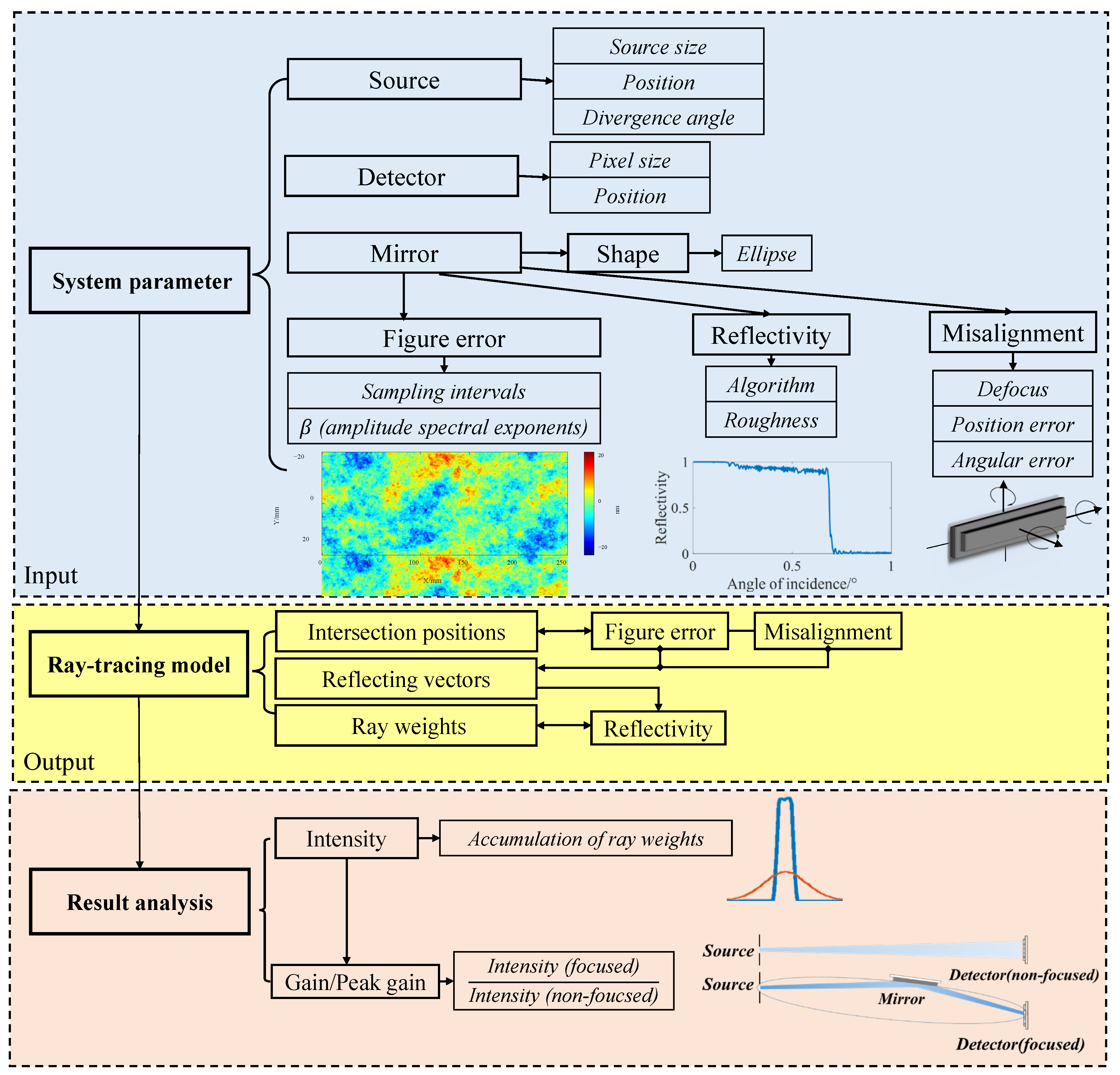
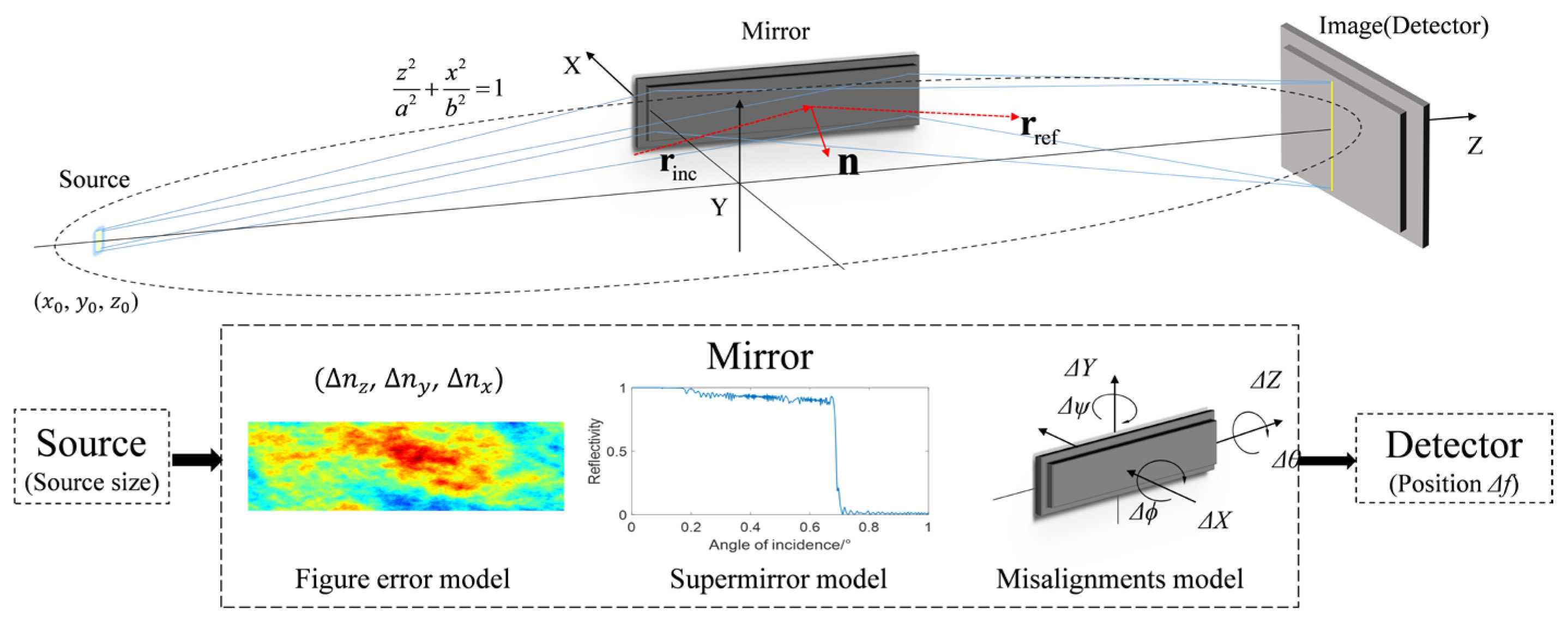

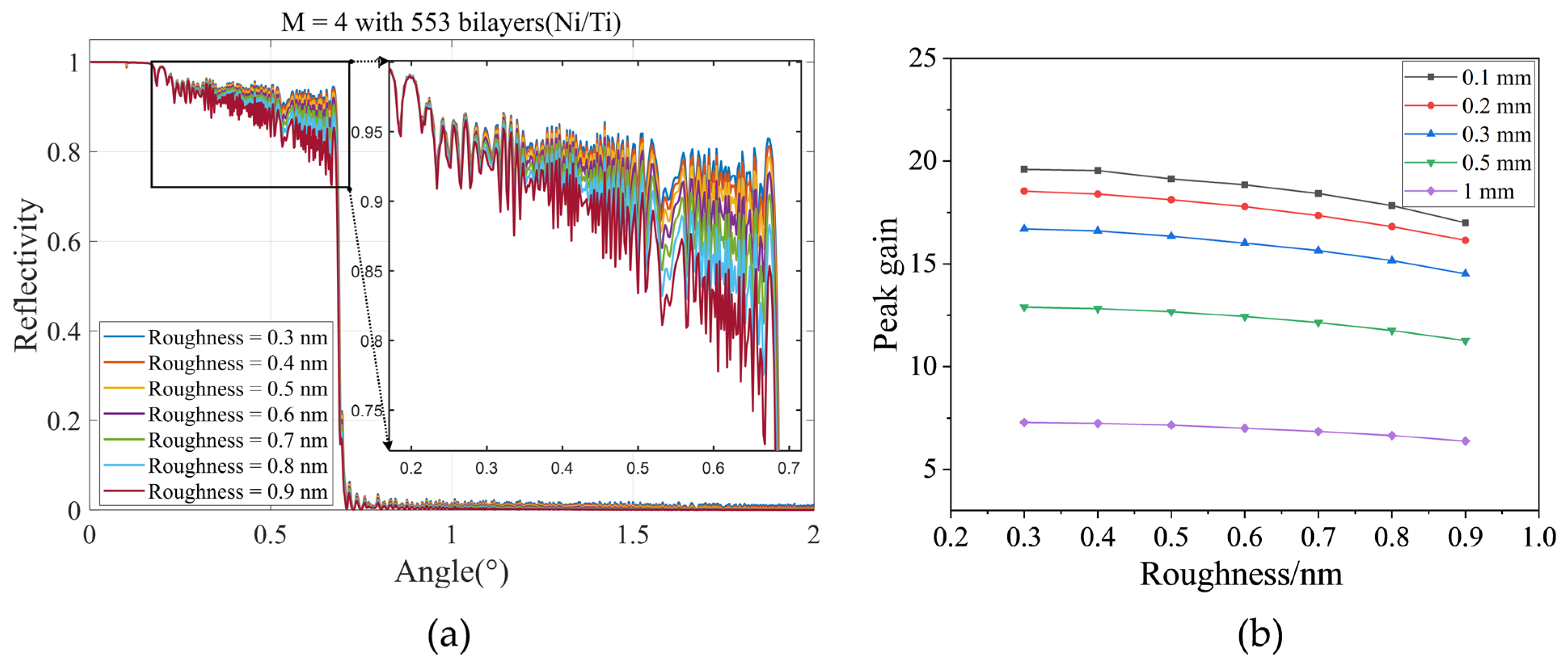


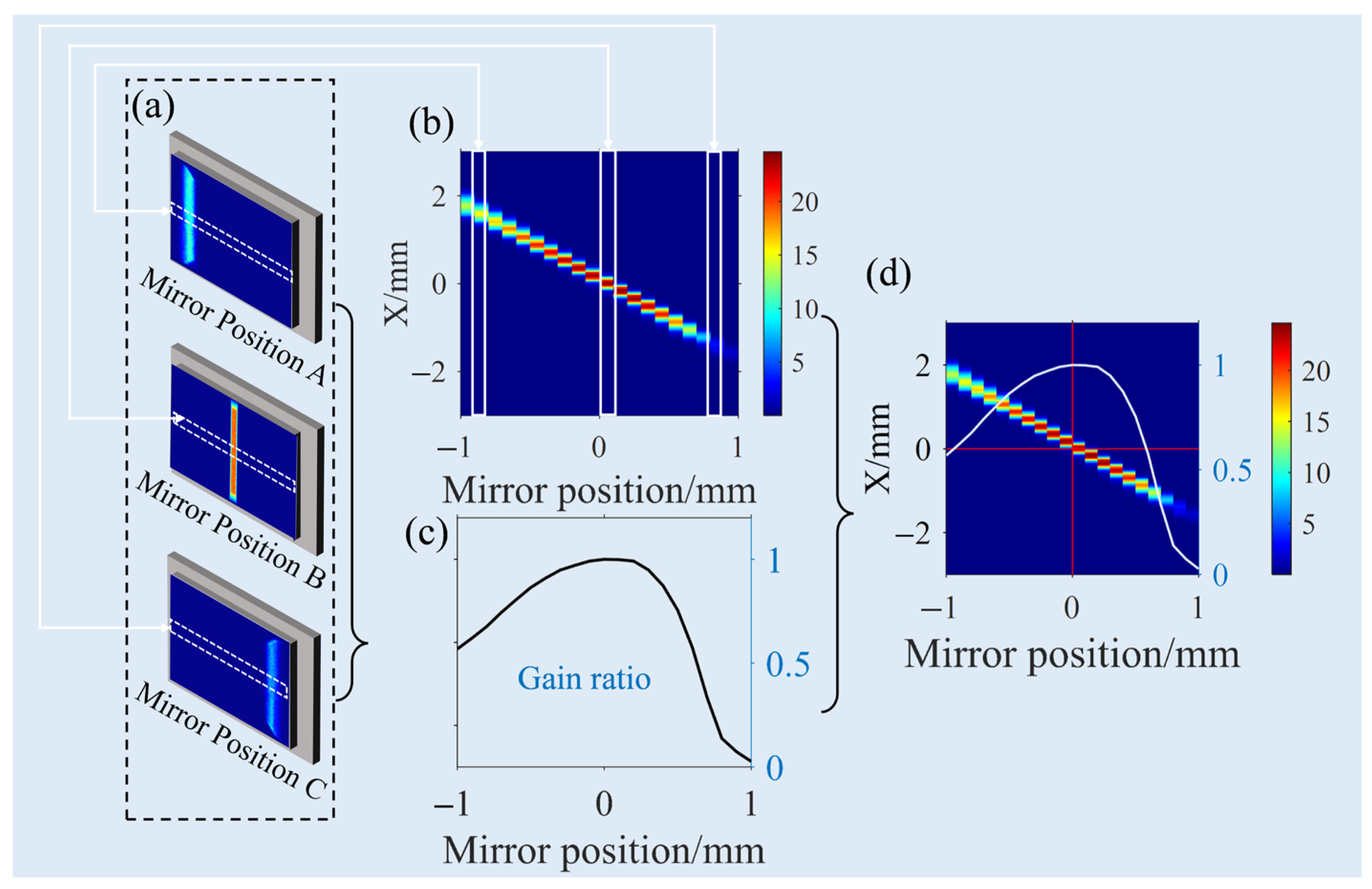


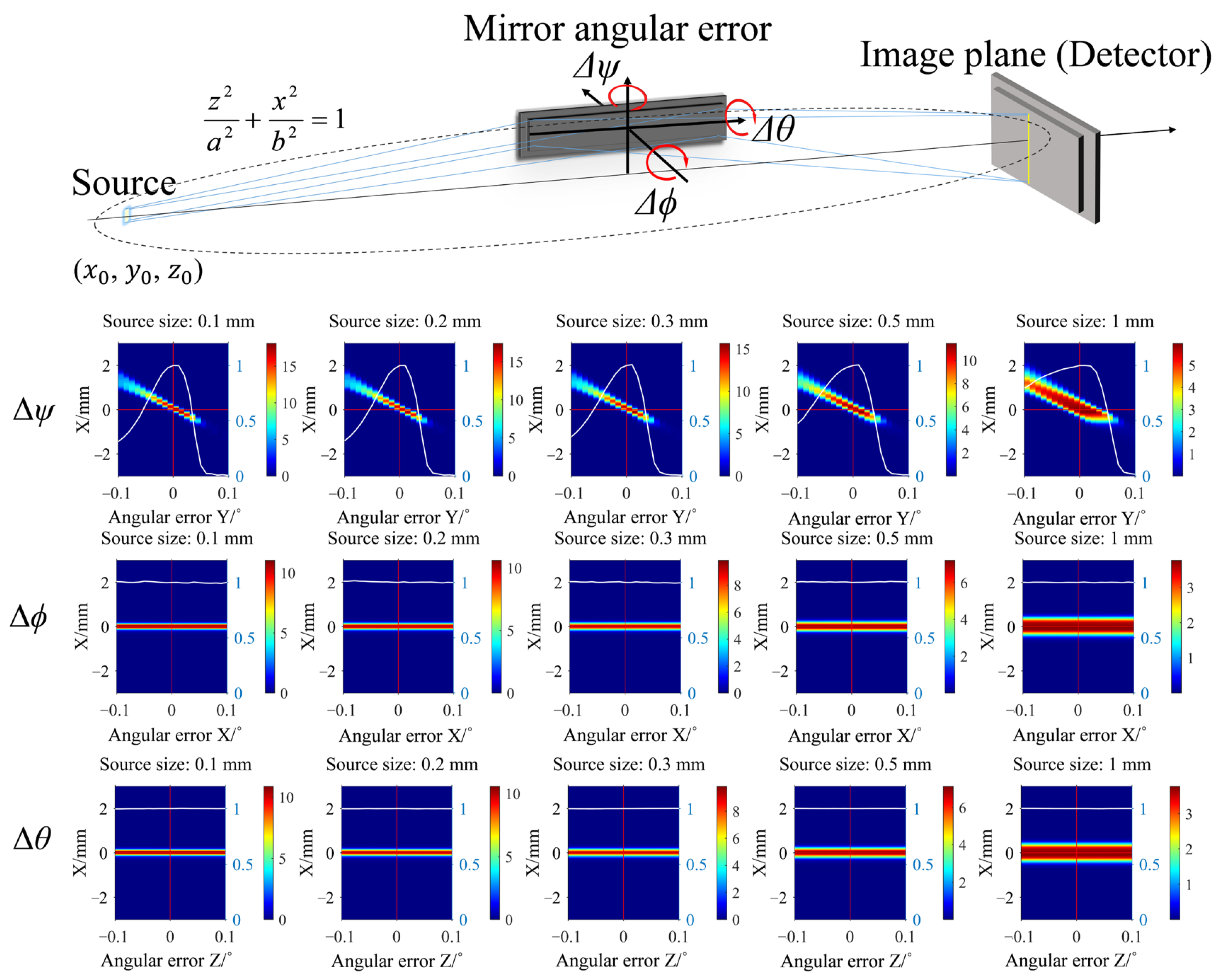

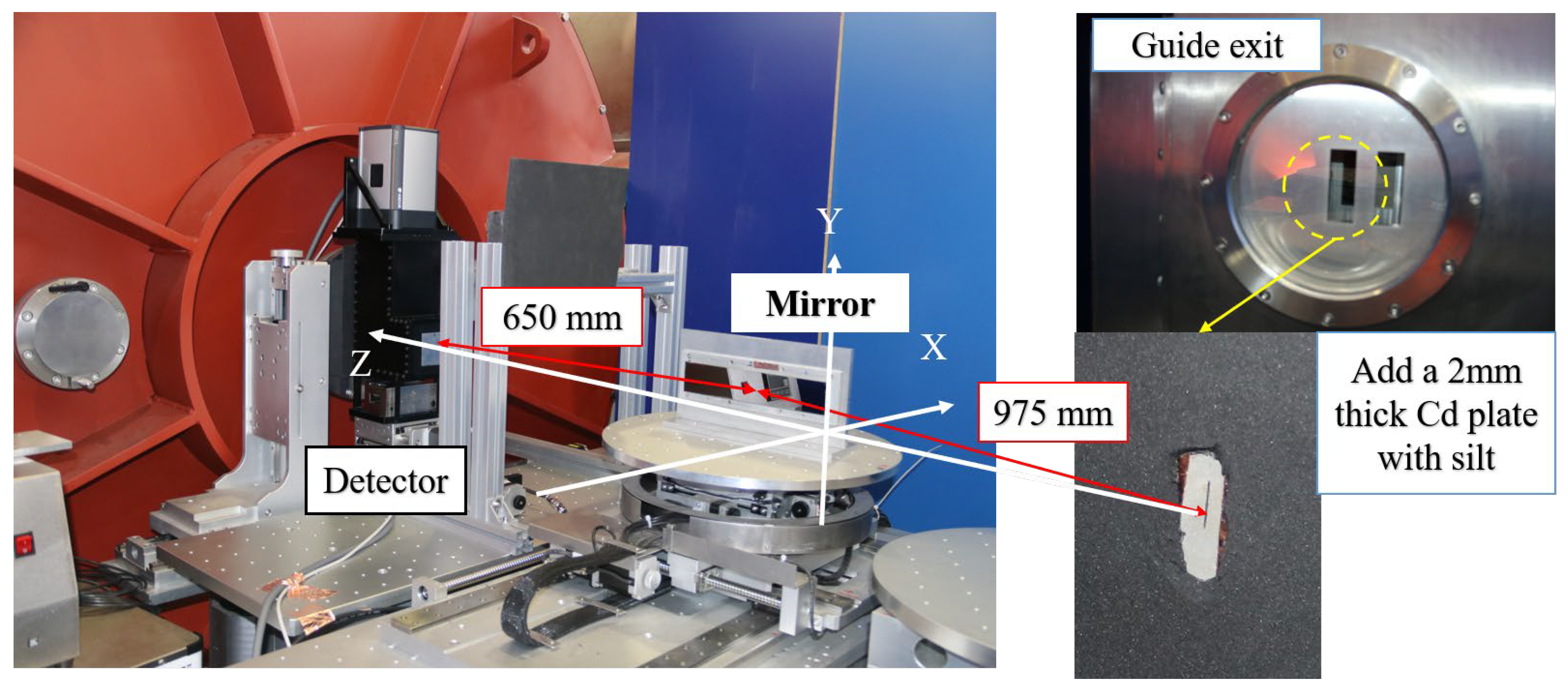
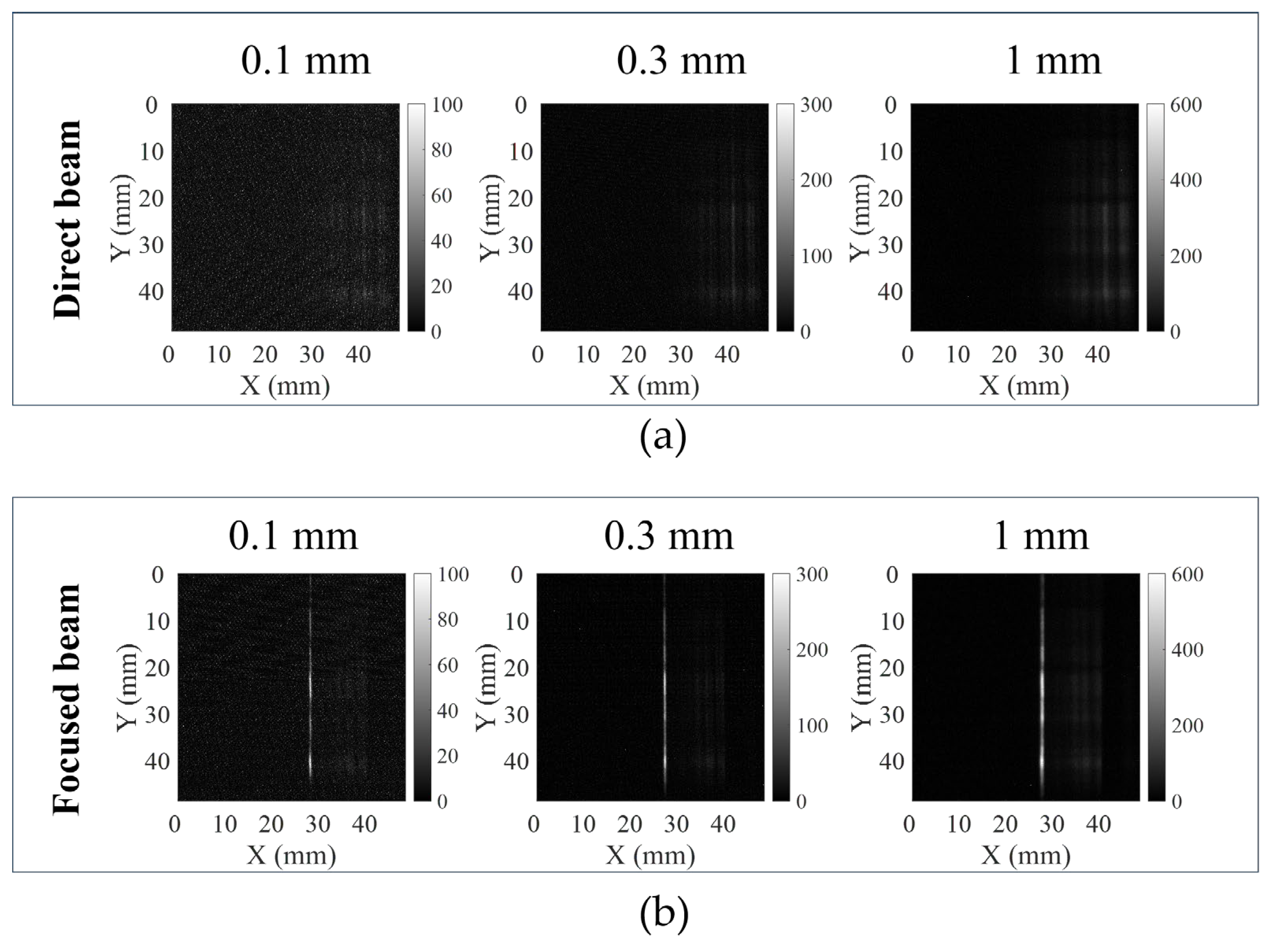
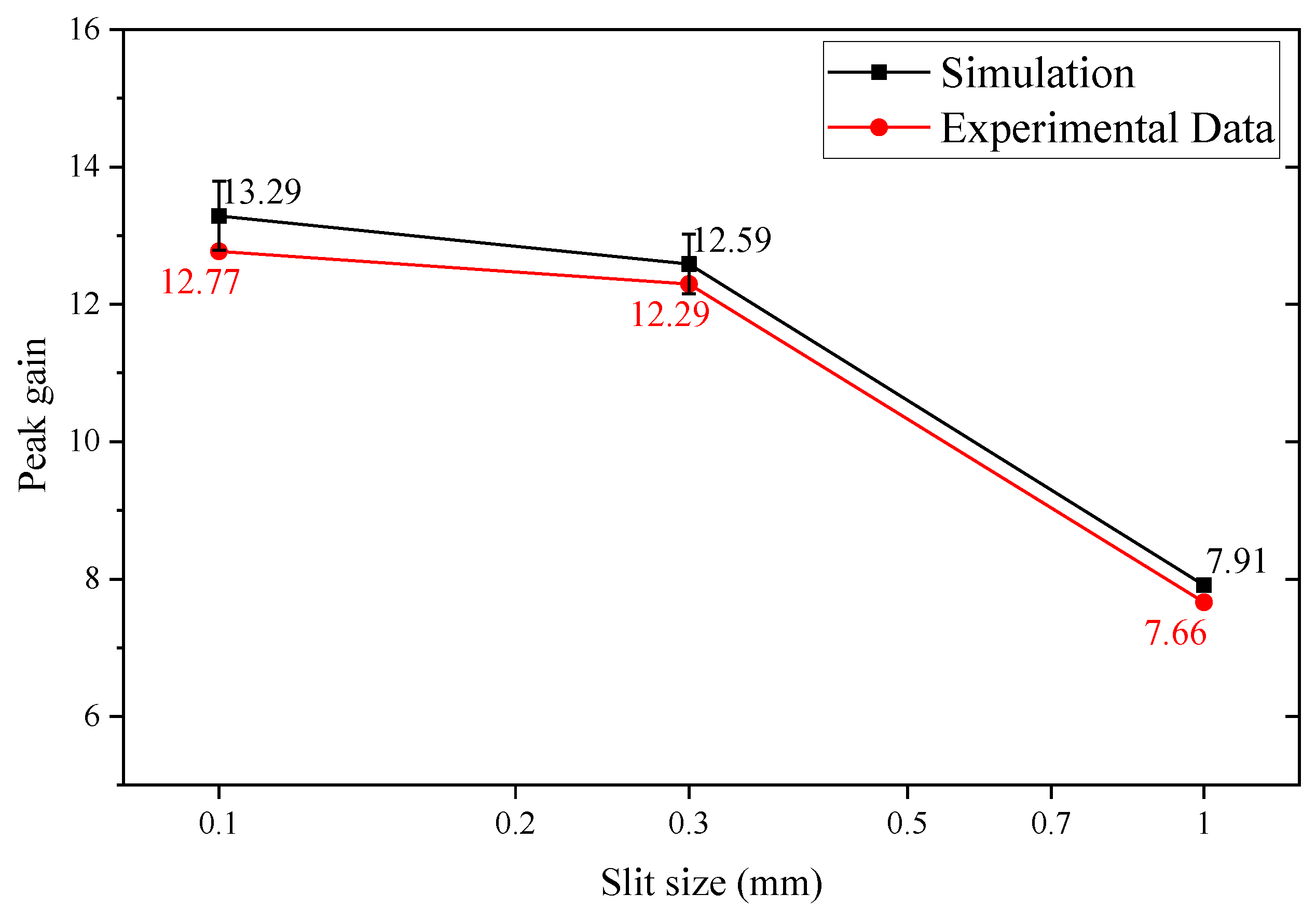
| Types of Error | Symbol |
|---|---|
| Defocus | Δf |
| Positional error Z | ΔZ |
| Positional error Y | ΔY |
| Positional error X | ΔX |
| Angular error Z | Δθ |
| Angular error Y | Δψ |
| Angular error X | Δϕ |
| Parameter | Value |
|---|---|
| Ellipse a | 850.0536 mm |
| Ellipse b | 9.5430 mm |
| Mirror length | 250 mm |
| Mirror center position | 125 mm |
| Divergence angle | 27 μrad |
| Critical angle of the mirror | 0.673° |
| Error | Tolerance Value |
|---|---|
| Slope error | <70 μrad |
| Roughness | <0.5 nm |
| Positional error X | −0.9~1 mm |
| Angular error Y | −0.08°~0.03° |
Disclaimer/Publisher’s Note: The statements, opinions and data contained in all publications are solely those of the individual author(s) and contributor(s) and not of MDPI and/or the editor(s). MDPI and/or the editor(s) disclaim responsibility for any injury to people or property resulting from any ideas, methods, instructions or products referred to in the content. |
© 2025 by the authors. Licensee MDPI, Basel, Switzerland. This article is an open access article distributed under the terms and conditions of the Creative Commons Attribution (CC BY) license (https://creativecommons.org/licenses/by/4.0/).
Share and Cite
Gu, W.; Yu, J.; Sheng, P.; Tang, F.; Zhang, Q.; Chen, P.; Wu, Q.; Song, W.; Cao, Z.; Shen, Z.; et al. A Comprehensive Error Analysis of the Neutron Elliptical Cylindrical Mirror with High Gain. Photonics 2025, 12, 580. https://doi.org/10.3390/photonics12060580
Gu W, Yu J, Sheng P, Tang F, Zhang Q, Chen P, Wu Q, Song W, Cao Z, Shen Z, et al. A Comprehensive Error Analysis of the Neutron Elliptical Cylindrical Mirror with High Gain. Photonics. 2025; 12(6):580. https://doi.org/10.3390/photonics12060580
Chicago/Turabian StyleGu, Weichen, Jun Yu, Pengfeng Sheng, Fengrui Tang, Qiya Zhang, Peng Chen, Qiaoyu Wu, Wentao Song, Zhangran Cao, Zhengxiang Shen, and et al. 2025. "A Comprehensive Error Analysis of the Neutron Elliptical Cylindrical Mirror with High Gain" Photonics 12, no. 6: 580. https://doi.org/10.3390/photonics12060580
APA StyleGu, W., Yu, J., Sheng, P., Tang, F., Zhang, Q., Chen, P., Wu, Q., Song, W., Cao, Z., Shen, Z., Zhang, Z., & Wang, Z. (2025). A Comprehensive Error Analysis of the Neutron Elliptical Cylindrical Mirror with High Gain. Photonics, 12(6), 580. https://doi.org/10.3390/photonics12060580






